Carelessness and poorly trained personnel are the main reasons for damage caused as a result of faulty palletization and unitization. The following applies: Once again, gaps are the main cause of all mechanical transport damage!
This carton really is in an exposed location. Would anyone actually load this pallet into a mixed consignment container? It is more likely that the steel straps will be cut away and the carton loaded as an individual item.
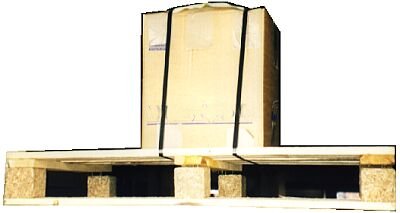 |
||
| Palletization which actually increases freight costs | ||
The combination of packaging receptacles, pallet and stretch wrap does not automatically result in a so-called "palletized load", as the example above shows. Only if the handling of pallets can be rationalized using ground conveyors can we really speak of palletized goods. These are handled by a number of companies at a cheaper rate.
Errors that occur frequently are demonstrated by these photographs:
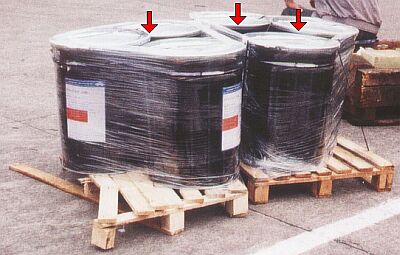 |
||
| Goods that are not safe for carriage | ||
The quick lever-closure drums shown here are basically not suitable for transportation, since the lids are able to push each other open. This applies to both conventional methods of stowage and to palletization. If this does not happen when the goods are wrapped, as in this case, then it will occur at the very latest when the load is jolted during transport.
Pallets do not usually have diagonal bars which means that are very susceptible to asymmetric forces. In particular when used in containers, pallets can only really be used sensibly when they can be packed flush and have level sides and surfaces. Gaps make it more difficult to pack and secure the load. Shrink and stretch wrap must firmly bond the goods to the pallets. This bond should be able to withstand the normal loads caused by handling. That is not the case here.
When loads arrive at a container packing station in such a pitiful state, the drums should be packed individually. It is obvious that drums or pails designed for use in containers can save on costs.
This picture demonstrates the potential danger that may arise when badly packed pallets are not rigorously unpacked, and instead an attempt is made to load them despite their obvious deficiencies:
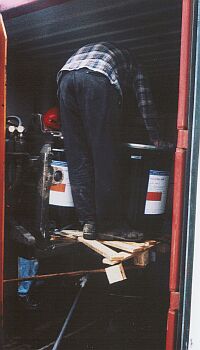 |
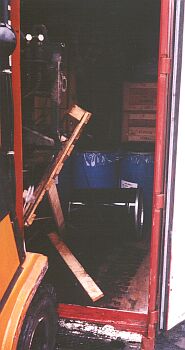 |
|
| An accident waiting to happen due to badly loaded pallets | ||
Despite the fact that this is not permitted, a loader can be seen climbing onto the pallet lifted by the forklift truck in an attempt to stabilize the load. This attempt fails and the drums fall to the ground.
The package illustrated appears, at first glance, to be a perfectly good shrink-wrapped pallet containing boxed goods. The wider dimensions of the load toward the top, i.e. the fact that they extend beyond the bounds of the pallet, may mean that the goods are forced into a gap that is too small for them because they no longer have dimensions suitable for the means of transport. The cartons stacked on top restrict the options for packing other goods on top of this package. In the real world, many packers would slice open the shrink wrap and load these two cartons separately. This subsequently increases the probability of incorrect delivery. A possible reason for this type of unacceptable palletization is that producers tend to apply their pricing/discounting system to round numbers like, for example, 50 or 100 instead of matching it to the capacity of loading aids, transport aids or means of transport.
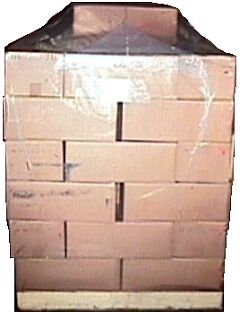 |
Two cartons too many! |
The most frequently seen error is pallets that are not packed flush.
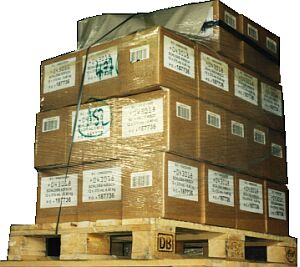 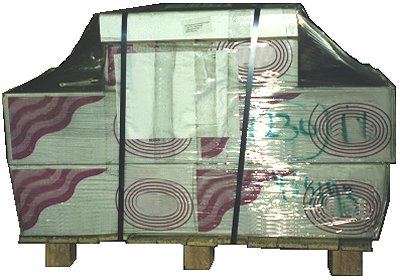 |
||
| Incorrectly packed pallets containing boxed goods | ||
Whether the goods are too small for their pallet, extend beyond the bounds of the pallet or are placed diagonally on the pallet, all these instances encourage careless loading into vehicles and containers, make load securing more difficult and can ultimately lead to the load being damaged.
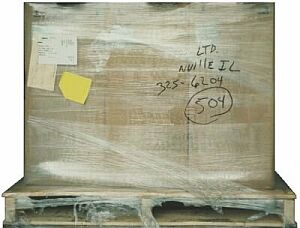 |
 |
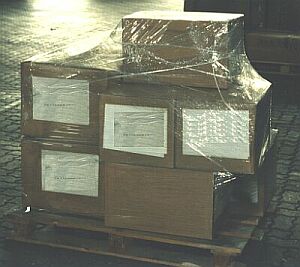 |
||
| Faulty palletization | ||
Bad palletization is not restricted just to boxed goods. When loading containers with hazardous goods you will often see badly shrink-wrapped or badly strapped pallets.
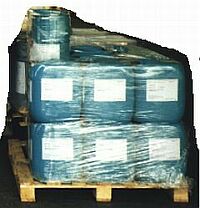 |
Load unit that is not suitable for transportation |
These load units cannot be stacked. Under the slightest acceleration, the badly wrapped film will not be able to hold the plastic canisters and tin drums in place on the pallet.
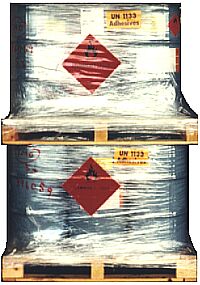 |
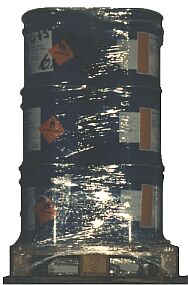 |
These load units are generally well packed, the surfaces are level and they can be stacked. Unfortunately, however, the sides are not perfectly flush with the pallet base. There are still gaps that should be filled.
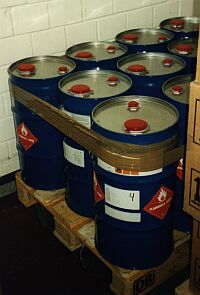 |
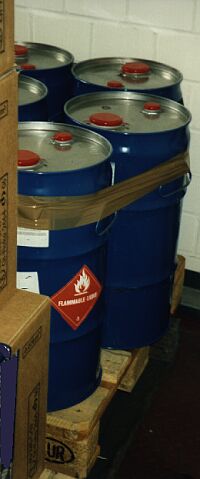 |
|
| Deficiencies when forming load units | ||
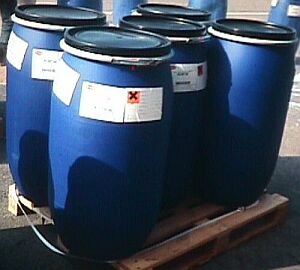 |
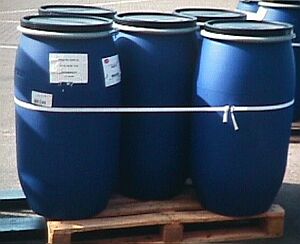 |
Note: Ignore palletization ... |
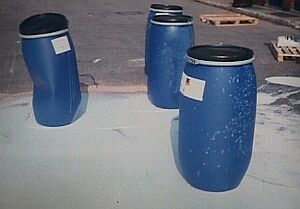  |
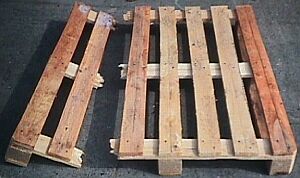 |
... at your peril! |
Goods that are palletized this badly cannot be stowed safely and without gaps, as the regulations require, without additional outlay in terms of work and materials.
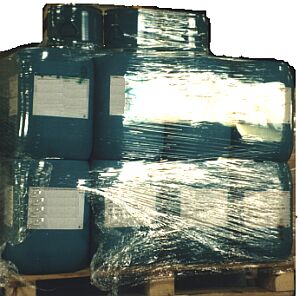 |
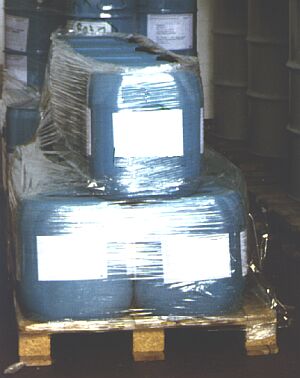 |
||
| Upper and lower images: Load units that contravene the regulations |
||
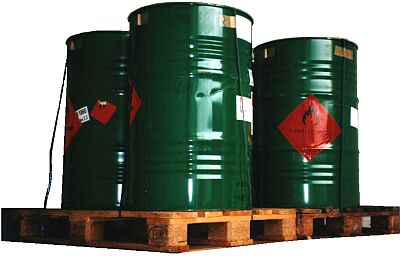 |
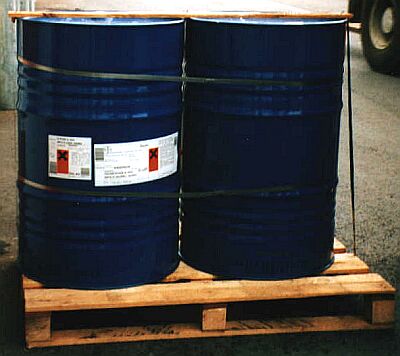 |
||
| Upper and lower images: Unacceptable packing of pallets with drums |
||
In road and rail transportation, actions that contravene the general guidelines on palletization can be compensated for by additional outlay on stowage and securing. In maritime transportation and when dealing with hazardous goods, packages of this nature are clearly in breach of the law. The general provisions of the German GGVSee, a German translation of the IMDG code state that the unitization and labeling of items and unit loads to be transported must be carried out in accordance with the regulations. In section 10.18 of the IMDG code, unit loads are defined as a number of packages that are
- placed or stacked on and secured by strapping, shrink-wrapping or other suitable means to a load board such as a pallet;
- placed in a protective outer enclosure such as a pallet box;
- permanently secured together in a sling.
- It may occur that the packages in a unit load will need to be separated. In this event, it must be ensured that the individual packages can be handled safely.
- The unit loads should be compact, have as regular a form as possible, and for the most part, vertical sides. The top of the unit load should be level. It must be possible to stack the unit loads. They must be constructed and secured in such a way that it is unlikely that the individual packages can become damaged.
- The unit loads must be sufficiently strong to withstand repeated loading and stowing operations and they must be able to bear unit loads with a similar specific mass which are stacked on them to a height commonly occuring during transportation.
- The material used to bind a unit load together must be compatible with the substances contained in the unit load and must remain effective under the influence of moisture, extreme ambient temperatures and sunlight.
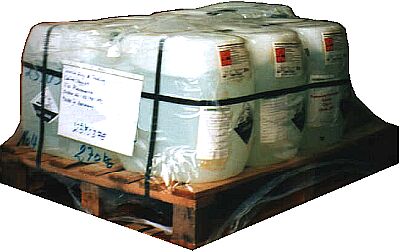 |
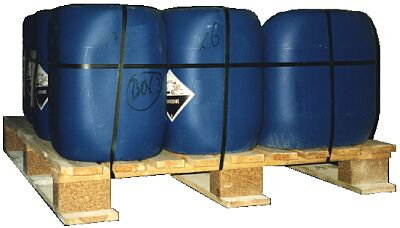
|
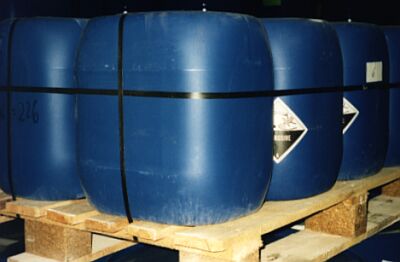
|
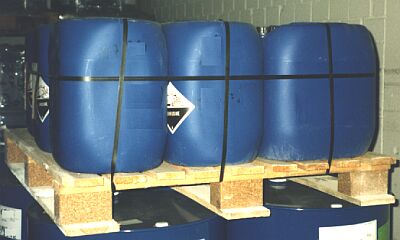
|
||
| Palletization of plastic canisters contrary to regulations | ||
Without the additional use of appropriate corner rails or cover boards, the straps alone will not be able to hold the plastic receptacles in place for very long. It is only possible to stack further unit loads on top of these with additional effort. When stowing the second or third layer, the goods stowed below must be protected from potentially damaging pressure by the use of additional measures.
Deficiencies can also be observed in the unit loads shown below:
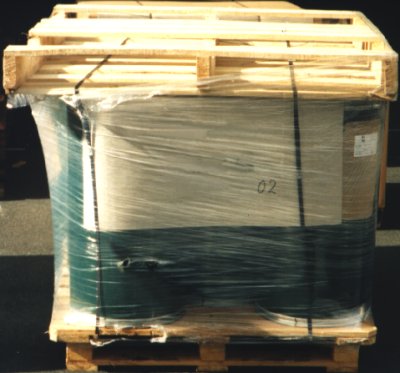 |
||
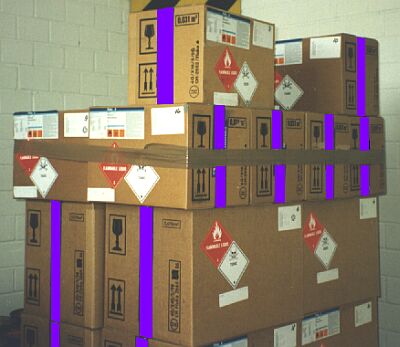 |
||
| Upper and lower images: Unit load with serious deficiencies | ||
Changing proportions lead to increased freight costs since the outer dimensions are measured. If the pallet placed on top of these drums can be brought into the correct position, it will no longer be able to bind the load together securely. The tape wrapped around these cartons and the stretch wrap round the cases must be used correctly.
All in all, the only recommendation that can be made here is to separate the packages and load them individually.
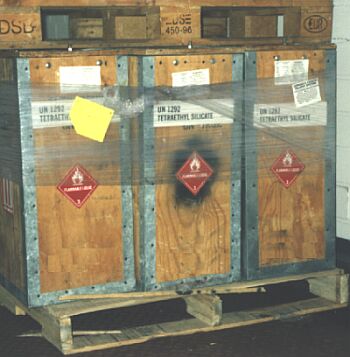 |
||
| Unit load with obvious deficiencies | ||
If the lower pallet is intended to be part of the unit load then it should be firmly bonded to the rest of the load. That is obviously not the case here. Without the pallet, this "pack of three" cannot be handled by forklift truck and thus cannot be loaded rationally. The stretch wrap itself is unable to provide sufficient stability.
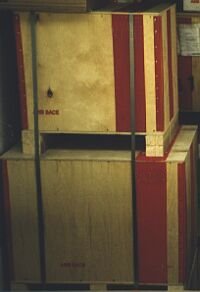 |
Less than perfect: A unit load that is not flush |
The benefits afforded by the efficient handling of unit loads are lost if gaps are left in the cargo. For the purposes of load securing, it would be more effective if each of the cases had been strapped separately.
Pallets should always be packed in such a way that the goods being transported, whether it be in cartons, sacks, pails, drums or canisters, are always flush with the pallet. Furthermore, only pallets should be used which are suitably dimensioned for the intended transportation method and the handling equipment that will be used.
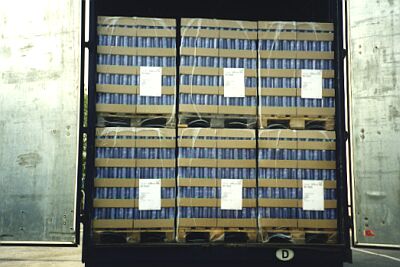 |
||
| Pallets that are appropriately dimensioned for transportation by truck |
||
The trays containing empty cans are designed for use with the pallets used here. The pallets themselves are compatible with the dimensions currently used for road and rail vehicles, swap bodies and inland containers in Europe. Thus, two pallets can be loaded next to each other widthways or three pallets lengthways. For the purposes of overseas transportation, there are currently very few containers with an internal width greater than 2.4 m. Thus, these pallets are not suitable for transportation in overseas containers. The European transportation market now has a small number of CPCs or "Cellular Palletwide Containers".
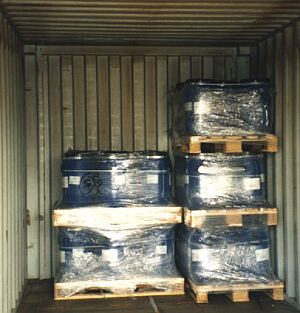 |
||
| Pallets that are not designed for the container | ||
The packing receptacles are not designed for the pallet, and the pallets themselves are not designed for use with this container. This makes loading and unloading more difficult and increases the amount of securing that is required.
The risk of damage also increases.
It would have been more sensible to use pallets or pallet-like bases sized 116 cm x 116 cm for transport in the container. This would have allowed two units to be loaded into the container next to each other in normal steel corrugated containers. The goods themselves should be packed in modular unit load packaging such as cartons, canisters, drums etc. which would allow a clean block to be formed on the pallet.
 |
Telescope cartons with pallet-like bases designed for use in the container |
Here the requirement for harmonized dimensions has been implemented and not just in terms of width, but also in terms of height. The telescope cartons fit tightly into the container and need no additional securing.
The stability of the cartons is, however, a possible point of criticism. Whether these are likely to survive the rigors of transportation is a matter of doubt. Interlayer dunnage with a large surface area would improve the situation. It may even be possible to support this dunnage for the lower and middle layer. If the contents are heavy it may be necessary to find out whether the four lengthwise slats on the pallet-like bases would cause pressure damage on the bottom of the cartons.
Continued in Section 4.1.2.2